A patio heater is a convenient way to keep your favorite outdoor spaces cozy and warm even when the temperatures are cool. They can be used in a variety of locations including your deck, patio, or backyard. However, many first time owners have one specific question on their minds. Can I use my patio heater underneath a covered patio?
The answer is . . . it depends. There are many factors to consider including the size and layout of your patio and the type of patio heater that is used. This article will answer all of your questions and show you how to safely use your patio heater.
Patio Safety Measures to Consider
Before using any type of patio heater, there’s a couple of safety aspects that you need to consider before setting up your heater. These steps will help prevent accidents and keep your patio heater running smoothly.
1. Read the Safety Manual
When you purchase a new patio heater, before you do anything else you must familiarize yourself with the owner’s manual. The manufacturer’s user guide will provide valuable information about the device’s heat output, how to properly use the heater, and what conditions are ideal for use. Every patio heater is different so it is important to follow the manufacturer’s specific instructions exactly as they are written.
2. Know the Clearance Requirements
While reading the instruction manual, take note of the recommended clearance for your heater. The “clearance” refers to the amount of space that is required around to safely use your outdoor heater. This information can be found in the owner’s manual. The amount varies based on the design and size of the heater, but generally there should be at least two feet of space on all sides of the heater (including above). This will help find the best location to place your patio heater.
3. Check Ventilation
If you want to use a patio heater beneath a covered patio, you should ensure that there is plenty of ventilation. Typically, even covered patios are very well ventilated with open sides, but if the design of your patio is closed off and has limited airflow, it is not recommended that you use an outdoor patio in this space.
4. Ensure Stability
Make sure that your patio heater is placed on a flat, level surface. When a heater is placed on an incline, there is a greater chance that it could get knocked over and potentially cause a fire.
5. Clear Away Any Combustible Materials
Before lighting your heater, ensure that there are no materials close to your patio heater that could accidentally catch flame. Items like umbrellas, wood, lattice, or outdoor cushions should be kept at least six feet away from the patio heater.
6. Keep It Covered
Generally patio heaters are not waterproof. Make sure that your patio heater is protected from the outdoor elements and working properly by using a protective cover when not in use. Make sure your patio heater has completely cooled before placing the cover over it.
Patio Heater Types
Propane
Propane heaters are a convenient way to get low-maintenance, cozy heat at the touch of a button. Propane heaters are available in a variety of styles and often require a 20 lb propane tank for fuel. Propane space heaters and tabletop heaters typically require small amounts of clearance and can be safely used under a covered patio as long as there is proper ventilation. Mushroom style propane heaters (also known as umbrella style heaters) are thin patio heaters that are typically between 7’ to 8’ tall and are available in fixed, tabletop, and portable options. If you choose a non-tabletop option, it’s important to pay attention to the clearance requirements of your mushroom patio heater because they are so tall. Generally, it is safe to use a patio heater beneath a covered patio as long as the covering is at least 10 feet tall. When using a propane heater of any style, angle the heater towards the open side of the patio for the best heat distribution.
Electric
Electric space heaters are one of the best options available for underneath a covered patio. Not only are they easy to use and portable enough that they can be moved from place to place, electric heaters are typically low to the ground so they require very little clearance. Like propane heaters, angling the heater towards the open side will help ensure the perfect heat distribution.
Fire Pits & Chimineas
Wood-burning fire pits and chimineas make excellent gathering places in your backyard, but they should never be used underneath a covered porch or patio. Wood-burning fires can release sparks, embers, and creosote which can cause dangerous accidents as well as damage your property. Wood-burning fire pits also produce smoke and fumes. This can build up and rapidly deplete the oxygen in an area as well as potentially damage your ceiling.
On the other hand, gas fire pits can be used under covered areas as long as certain criteria are met. Unlike wood-burning fire pits, propane fire pits feature a highly controlled flame and do not produce any smoke. First, check with your city and make certain there are not any local regulations that will prevent you from placing a gas fire pit beneath a covered area. Your fire pit should also be located at least 10 feet away from your house. There should also be at least 7 feet of clearance between the flames and the ceiling. Also, make sure the type of flooring can support both the weight and the heat of the fire pit table.
For more information about where you can use a fire pit, check out our blog article The 5 Do’s and Don’ts When Using a Fire Pit on a Wood Deck.
Don’t let the chilly weather drive you indoors. Patio heaters allow you to spend plenty of time enjoying the outdoors. As long as you take a little time to consider your patio and research patio heaters before you purchase, you are sure to find the best heater to keep your covered patio warm and toasty.





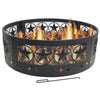

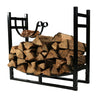





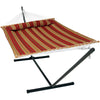






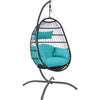










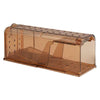

































3 comments
Leon
I have a 20 × 20 covered, open patio. The north wall is brick as is the east wall. Have fostered 2 stray, feral cats. In the corner is a cat house with electric heating pad & the exterior is insulated. Want to place an electric heater pointed to the doorway to increase comfort. By design I’ve never seen moisture in that corner as well most of the patio. I’ve always been advised no electric heaters in this scenario. All due respect your article says it’s ok. Please confirm that it is acceptable. Thank you.
Jim Bonham
I have a 16’×20’patio enclosure that has 10 windows that open I have tried electric space heaters they don’t work what propane heater can I get to heat up the room
Olivia Smart
Thank you for discussing propane patio heaters. I’ve been thinking about getting some patio heaters so we can enjoy our new outdoor space during the winter. It seems like these could be a good option for us, so I’ll start looking into getting something like this for the space. https://patioheaterusa.com